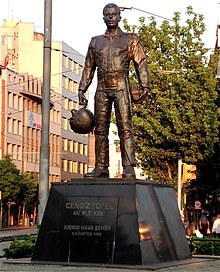Turkish Cypriot nationalism
Turkish Cypriot nationalism is an ethnic nationalism supporting the independence of the Turkish Republic of Northern Cyprus (TRNC) and mostly desires that the TRNC stay independent from Turkey while opposing the idea of a united Cyprus with the Greek-dominated Republic of Cyprus. The objective of taksim, that is, the partition of the island of Cyprus into Turkish and Greek portions, is widespread among Turkish Cypriot nationalists. Nevertheless, a considerable number of them wish for Turkey to annex Cyprus.[1][2]
History

In 1911, 3 rallies against
In 1950s and 1960s, Turkish Cypriot nationalism developed mainly in response to
On 6 August 1964, units of the Cypriot National Guard and Turkish Cypriot armed groups started to clash near Kokkina. On 8 August 1964, after waiting for nearly two days, Turkey intervened, once it had become clear that the Greek Cypriots would not withdraw from Kokkina, but simply commit more and more siege forces until the Turkish Cypriots ran out of supplies. The incident was an important turning point in both Turkish and Turkish Cypriot nationalism, and it caused a massive increase in nationalist opinions among the Turkish Cypriots. This increase was mostly in favour of idea of Turkish annexation of Cyprus.[13][14]
On 20 July 1974, Turkey launched an invasion of the island following a Greek Junta sponsored coup d'état against President Makarios, aimed at uniting the island with Greece. The second Turkish offensive, codenamed "Attila 2", took place between 14 and 18 August 1974 and extended as far west as the Kokkina enclave.
See also
References
- ^ Xypolia, Ilia (2017). British Imperialism and Turkish Nationalism in Cyprus, 1923-1939 : divide, define and rule. London: Routledge.
- ISBN 978-1317032748.
The rise of Turkish nationalism among the Turkish Cypriots can be largely seen as a response to the Greek Cypriot national "awakening" and campaign for union with Greece.
- ^ "KIBRIS". users.metu.edu.tr. Retrieved 2020-12-22.
- OCLC 1106094476.
- ^ Kızılyürek, Niyazi (2003). "The politics of identity in the Turkish Cypriot community : a response to the politics of denial?". Travaux de la Maison de l'Orient méditerranéen. 37 (1): 197–204.
The Turkish Cypriot nationalism developed mainly in reaction to the Greek Cypriot national desire for union with Greece.
- ISBN 978-1317344667.
- ISBN 9780253111913.
- ISBN 9780230392076.
- ISBN 9780857711939.
- ISBN 9780810862982.
Greek Cypriots engaged in a military campaign for enosis, union with Greece. Turkish Cypriots, in response, expressed their desire for taksim, partition of the island.
- ISBN 978-0-300-18351-1.
In line with the nationalist rhetoric that "Cyprus is Turkish", Menderes predicated his declaration upon the geographic proximity between Cyprus and Anatolia, thereby defining "Cyprus as an extension of Anatolia". It was striking that Menderes rejected partitioning the island into two ethnic states, a position that would define Turkey's foreign policy regarding Cyprus after 1957
- ISBN 978-88-89465-07-3.
The educational and political mobilisation between 1948-1958, aiming at raising Turkish national consciousness, resulted in the involving Turkey as motherland in the Cyprus Question. From then on, Turkey, would work hand in hand with the Turkish Cypriot leadership and the British government to oppose the Greek Cypriot demand for enosis and realise the partition of Cyprus, which meanwhile became the national policy.
- ^ Pierre Oberling, The road to Bellapais: the Turkish Cypriot Exodus to Northern Cyprus, Social Science Monographs, 1982, p. 120.
- ISBN 978-0-230-27528-7.
